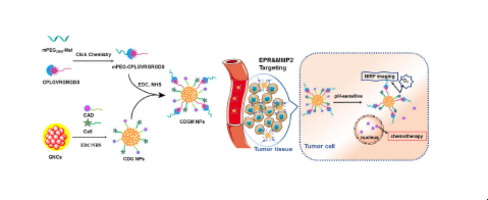Acta Biomaterialia ( IF 9.4 ) Pub Date : 2017-12-30 , DOI: 10.1016/j.actbio.2017.12.034 Fangfang Xia , Wenxiu Hou , Chunlei Zhang , Xiao Zhi , Jin Cheng , Jesús M. de la Fuente , Jie Song , Daxiang Cui

|
Nanoparticle-based drug delivery systems have drawn a great deal of attention for their opportunities to improve cancer treatments over intrinsic limits of conventional cancer therapies. Herein, we developed the polypeptide-modified gold nanoclusters (GNCs)-based nanoprobes for tumor-targeted near-infrared fluorescence imaging and chemo-photodynamic therapy. The nanoprobes comprise of tetra-functional components: i) polyethylene glycol (PEG) shell for long blood circulation and better biocompatibility; ii) MMP2 polypeptide (CPLGVRGRGDS) for tumor targeting; iii) cis-aconitic anhydride-modified doxorubicin (CAD) for pH-sensitive drug release; iv) photosensitizer chlorin e6 (Ce6) for photodynamic therapy and fluorescence imaging. The in vitro results demonstrated that the as-synthesized nanoprobes could be efficiently internalized into A549 cells and then significantly enhance the mortality of cancer cells compared with free Ce6 and doxorubicin. For in vivo tests, the nanoprobes showed excellent tumor targeting ability and long blood circulation time and could remarkably inhibit the growth of tumor. Our results will help to advance the design of combination strategies to enhance the efficacy of imaging-guided cancer therapy.
Statement of significance
The as-prepared CDGM NPs could accumulate into the tumor tissue with the enhanced permeability and retention (EPR) effect as well as the active tumor targeting ability from the MMP2 polypeptides.
With the acid-sensitive linker, the doxorubicin (DOX) would be released from the synthesized nanoparticles after exposing to the acid tumor microenvironment.
The CDGM NPs exhibit excellent tumor targeting ability and could remarkably suppress the growth of tumor compared with free Ce6 and DOX.
中文翻译:

用于肺癌的pH响应性金纳米簇基纳米探针靶向近红外荧光成像和化学光动力疗法
基于纳米颗粒的药物输送系统因其有机会在常规癌症治疗的固有限制范围内改善癌症治疗方法而备受关注。在这里,我们开发了基于多肽修饰的金纳米簇(GNCs)的纳米探针,用于肿瘤靶向的近红外荧光成像和化学光动力疗法。纳米探针包含四功能组分:i)聚乙二醇(PEG)壳,可延长血液循环并具有更好的生物相容性;ii)用于肿瘤靶向的MMP2多肽(CPLGVRGRGDS);iii)用于酸敏感性药物释放的顺式乌头酸酐修饰的阿霉素(CAD);iv)光敏剂二氢卟酚e6(Ce6),用于光动力疗法和荧光成像。在体外结果表明,与游离的Ce6和阿霉素相比,合成后的纳米探针可以有效地内化到A549细胞中,然后显着提高癌细胞的死亡率。对于体内测试,纳米探针显示出优异的肿瘤靶向能力和较长的血液循环时间,并且可以显着抑制肿瘤的生长。我们的结果将有助于推进组合策略的设计,以增强影像引导癌症治疗的功效。
重要声明
所制备的CDGM NPs可以以增强的通透性和保留(EPR)效应以及MMP2多肽的主动肿瘤靶向能力积聚到肿瘤组织中。
使用酸敏感性接头,在暴露于酸性肿瘤微环境后,阿霉素(DOX)将从合成的纳米颗粒中释放出来。
与游离的Ce6和DOX相比,CDGM NPs具有出色的肿瘤靶向能力,并且可以显着抑制肿瘤的生长。











































 京公网安备 11010802027423号
京公网安备 11010802027423号